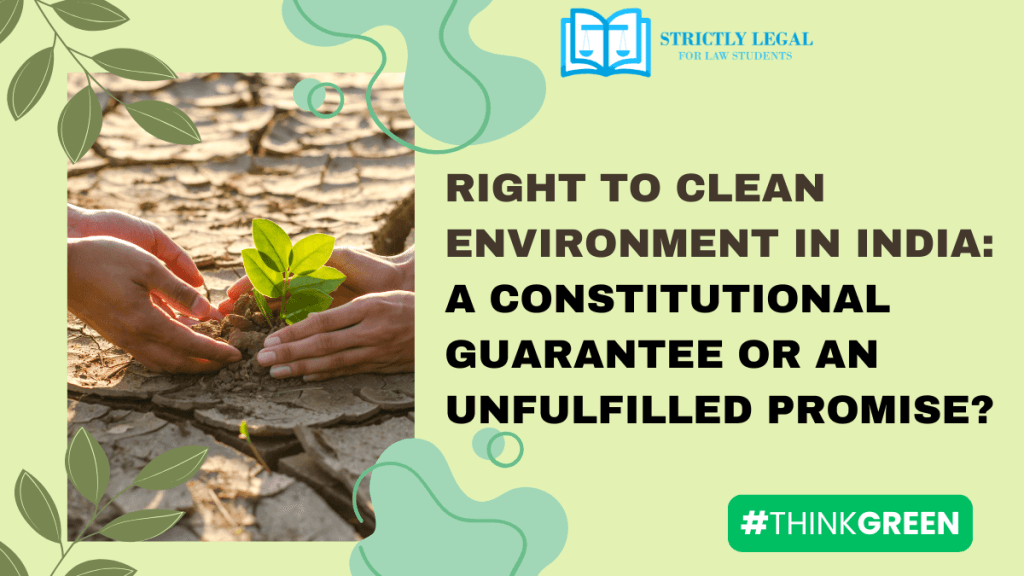“What we are doing to the forests of the world is but a mirror reflection of what we are doing to ourselves and to our fellow man.” – Mahatma Gandhi
The environment encompasses all the natural surroundings in which humans, animals, and plants coexist, including air, water, soil, climate, and ecosystems. It is a vital part of our existence, providing resources essential for life and maintaining ecological balance. However, the environment is increasingly threatened by pollution, deforestation, climate change, and unsustainable development, which jeopardize the health and well-being of all living beings. In India, the Right to Clean Environment has evolved as a crucial part of the Right to Life, which is enshrined in Article 21 of the Indian Constitution. While not explicitly stated in the Constitution, the Supreme Court of India has interpreted the right to a clean and healthy environment as a fundamental right, recognizing that a pollution-free environment is essential for the enjoyment of life and personal liberty. Over the years, judicial activism has played a significant role in expanding this right, leading to landmark rulings that have shaped environmental policy in India.
The Right to Clean Environment involves the legal recognition that individuals are entitled to live in an environment free from pollution, harmful emissions, and environmental degradation. This right not only protects individuals from the adverse effects of pollution but also ensures that sustainable development practices are followed to preserve natural resources for future generations. The establishment of various environmental laws and institutions, like the National Green Tribunal (NGT), has further reinforced this right by offering legal mechanisms for addressing environmental violations and providing remedies for those affected by environmental harm. Ultimately, the Right to Clean Environment highlights the interconnectedness of human well-being and environmental health, underscoring the need for legal, social, and economic efforts to safeguard the planet’s ecosystems and ensure a healthy and sustainable future.
International Measures for a Clean Environment
Universal Declaration of Human Rights (UDHR)
Article 25 of the UDHR states that “everyone has the right to a standard of living adequate for the health and well-being of himself and of his family, including food, clothing, housing, and medical care.” While the right to a clean environment is not directly mentioned, the emphasis on health and well-being implies the necessity of a clean environment as a foundational condition for the enjoyment of these rights.
International Covenant on Economic, Social and Cultural Rights (ICESCR)
The ICESCR, adopted by the United Nations General Assembly in 1966, recognizes the right to health as part of the broader right to an adequate standard of living. Article 12 of the ICESCR affirms the right of everyone to the enjoyment of the highest attainable standard of physical and mental health. This includes the obligation of States to prevent environmental and health hazards caused by pollution, which is implicitly linked to the right to a clean environment.
Stockholm Declaration (1972)
The Stockholm Declaration, adopted at the United Nations Conference on the Human Environment in 1972, was one of the first international documents to link human rights with environmental protection. Principle 1 of the declaration explicitly states that: “Man has the right to freedom, equality, and adequate conditions of life, in an environment of a quality that permits a life of dignity and well-being.” This principle laid the foundation for recognizing the right to a healthy environment as part of human rights law.
Rio Declaration on Environment and Development (1992)
The Rio Declaration emerged from the United Nations Conference on Environment and Development (UNCED), also known as the Earth Summit. Principle 1 reaffirms the link between human rights and environmental protection, asserting that: “Human beings are at the center of concerns for sustainable development. They are entitled to a healthy and productive life in harmony with nature.” It encourages countries to promote policies that ensure environmental sustainability while also safeguarding human rights.
Paris Agreement (2015)
The Paris Agreement, adopted under the United Nations Framework Convention on Climate Change (UNFCCC), aims to limit global warming and mitigate climate change, which has a direct impact on the environment and public health. While the agreement primarily focuses on climate change, it recognizes the importance of environmental protection for human rights, particularly in vulnerable communities. The Paris Agreement reflects the international community’s commitment to creating a clean and sustainable environment.
Sustainable Development Goals (SDGs)
The United Nations 2030 Agenda for Sustainable Development includes SDG 13 on climate action, as well as SDG 6 (Clean Water and Sanitation) and SDG 15 (Life on Land), which directly relate to environmental health. These goals focus on ensuring access to clean water, air, and natural resources, while addressing the impacts of environmental degradation on human well-being. A clean environment is thus framed as an integral component of sustainable development and human rights.
Legal Frameworks in India for a Clean Environment
India has developed a comprehensive legal framework to safeguard its environment and ensure a clean and sustainable environment for its citizens. The legal frameworks are rooted in both constitutional provisions and a range of statutory laws aimed at addressing pollution, conservation of natural resources, and promoting environmental sustainability.
Constitutional Provisions
Article 21 (Right to Life)
The Right to Life under Article 21 of the Indian Constitution has been interpreted by the Supreme Court of India to include the Right to a Clean Environment. In various landmark judgments, the Court has emphasized that living in a pollution-free environment is essential to a person’s dignity and well-being, and thus is part of the fundamental right to life.
Directive Principles of State Policy (Article 48A)
Article 48A mandates that the State shall “endeavor to protect and improve the environment and to safeguard the forests and wildlife of the country.” This provision reflects the State’s responsibility to promote environmental protection as a policy goal.
Fundamental Duties [Article 51A(g)]
Under Article 51A(g), it is the fundamental duty of every citizen to “protect and improve the natural environment including forests, lakes, rivers, and wildlife, and to have compassion for living creatures.” This legal provision reinforces the duty of citizens to engage in practices that safeguard the environment.
The Environment Protection Act, 1986
The Environment Protection Act (EPA) is one of the most significant pieces of legislation aimed at environmental protection in India. The Act empowers the Central Government to take measures to protect and improve the environment, such as laying down standards for air, water, and soil quality, regulating hazardous waste, and establishing environmental authorities. The Act also provides for the establishment of Environmental Protection Rules for controlling pollution and mitigating environmental harm across various sectors.
The Air (Prevention and Control of Pollution) Act, 1981
This Act aims to control and reduce air pollution in India. It establishes the Central Pollution Control Board (CPCB) and state-level boards for monitoring and regulating air quality, setting standards for emission levels, and taking action against industries and establishments that violate these standards. It also empowers the government to issue orders to prevent and control air pollution, including the closure of polluting industries and measures to control vehicular emissions.
The Water (Prevention and Control of Pollution) Act, 1974
This Act is designed to prevent and control water pollution by regulating the discharge of pollutants into water bodies. It establishes the Central Pollution Control Board (CPCB) and state-level boards to monitor water quality, set standards, and enforce regulations. The Act also allows for the establishment of sewage treatment plants, restrictions on the dumping of industrial waste into water bodies, and provides for penalties against offenders.
The Forest (Conservation) Act, 1980
This Act seeks to conserve India’s forests by regulating the diversion of forest lands for non-forestry purposes (such as mining, industrial development, and infrastructure projects). It mandates that any proposal for the diversion of forest land must be approved by the Central Government, and it has provisions for protecting forests against illegal deforestation and ensuring afforestation and reforestation efforts.
The Wildlife Protection Act, 1972
The Wildlife Protection Act provides for the protection of wildlife, their habitats, and conservation areas. It establishes protected areas such as national parks and wildlife sanctuaries and makes provisions for the protection of endangered species. The Act prohibits the hunting, poaching, or trade of wild animals and sets guidelines for the establishment of wildlife protection committees at the state and national levels.
The National Green Tribunal Act, 2010
The National Green Tribunal (NGT) Act established the NGT, a specialized body for the swift resolution of environmental disputes and the enforcement of environmental laws. The NGT has been given judicial powers to handle cases related to environmental protection and conservation, such as pollution control, forest conservation, and biodiversity protection. It provides an accessible forum for public interest litigations (PILs) concerning environmental matters.
The Noise Pollution (Regulation and Control) Rules, 2000
These rules set forward by the Ministry of Environment and Forests, aim to regulate and control noise pollution by setting limits on permissible noise levels in various areas, including residential, commercial, and industrial zones. They also provide for penalties for violations and measures to reduce noise pollution from sources like vehicles, construction, and public events.
Does the Indian Penal Code talk about it?
The Indian Penal Code (IPC), primarily designed to deal with general criminal offenses, also includes certain provisions that can be applied to environmental violations. While the IPC does not specifically focus on environmental issues, various sections can be invoked in cases related to pollution, environmental harm, and public health hazards that affect the right to a clean environment.
Section 268 – Public Nuisance
A public nuisance is an act that causes harm, inconvenience, or danger to the public or a section of the public. Pollution, contamination of water bodies, or deforestation that affects the well-being of the community can fall under this section.
Punishment: If someone causes a public nuisance, they can be punished with- Imprisonment for up to 3 months, or A fine of up to ₹200, or both.
Section 277 – Fouling Water of Public Spring or Reservoir
This section applies when a person fouls or pollutes any water source used by the public, including a public spring or reservoir, with the intention of causing harm.
Punishment: Imprisonment for up to 6 months, or a fine up to Rs. 1000 or both.
Section 278 – Making Atmosphere Noxious to Health
This provision applies when a person causes the atmosphere to become harmful to public health by emitting noxious substances, such as toxic gases, fumes, or chemicals.
Punishment: Imprisonment for up to 6 months, or fine up to Rs. 1000 or both.
Section 433 – Misappropriation of Water
This section addresses the unauthorized use or misappropriation of water, which is a valuable natural resource.
Punishment: Imprisonment for up to 3 years, and/or a fine.
Principles laid down by the Indian Judiciary for a Clean Environment
Polluter Pays Principle
(PPP) mandates that the polluter should bear the cost of damage caused to the environment. This principle was firmly established by the Indian judiciary in cases like the Indian Council for Enviro-Legal Action v. Union of India. It ensures that industries or individuals responsible for pollution are liable for the cost of cleanup and damage restoration.
Precautionary Principle
The Precautionary Principle directs that where there is a risk of significant environmental damage, preventive measures must be taken, even if there is no full scientific certainty about the harm. This principle was reinforced in the case of Vellore Citizens’ Welfare Forum v. Union of India (1996), where the court emphasized that precautionary measures should be adopted to avoid irreparable environmental harm.
Public Trust Doctrine
The Public Trust Doctrine asserts that certain natural resources like air, water, and forests are held in trust by the state for the benefit of the public. The Supreme Court in M.C. Mehta v. Kamal Nath (1997) applied this doctrine to prevent the unlawful use of public resources and ensure they are protected for public use.
Right to Clean Environment as Part of Right to Life
The Indian judiciary has interpreted Article 21 (Right to Life) of the Indian Constitution to include the Right to a Clean Environment. In Subhas Kumar v. State of Bihar (1991), the Supreme Court ruled that the right to life includes the right to live in a healthy environment, thus making environmental protection a fundamental right.
Conclusion
The Right to a Clean Environment is a fundamental aspect of human dignity and well-being, recognized not only in India’s Constitution but also through international human rights frameworks. It is integral to the Right to Life under Article 21 of the Indian Constitution and is supported by a robust legal framework. Despite the existing legal framework, the effective implementation and enforcement of environmental laws remain a significant challenge due to factors such as weak governance, industrial pressures, and lack of public awareness. Thus, it is essential to continue strengthening legal enforcement, raise environmental consciousness, and ensure the active participation of citizens, communities, and industries in environmental protection.

Law student.
Turning legal insights into engaging narratives.





